Ielts Academic Reading Sample 112
As high-tech materials invade high-street fashion, prepare for clothes that are cooler than silk and warmer than wool, keep insects at arm's length, and emit many pinpricks of coloured light.
The convergence of fashion and high technology is leading to new kinds of fibres, fabrics and coatings that are imbuing clothing with equally wondrous powers. Corpe Nove, an Italian fashion company, has made a prototype shirt that shortens its sleeves when room temperature rises and can be ironed with a hairdryer. And at Nexia Biotechnologies, a Canadian firm, scientists have caused a stir by manufacturing spider silk from the milk of genetically engineered goats. Not surprisingly, some industry analysts think high-tech materials may soon influence fashion more profoundly than any individual designer.
A big impact is already being made at the molecular level. Nano-Tex, a subsidiary of American textiles maker Burlington, markets a portfolio of nanotechnologies that can make fabrics more durable, comfortable, wrinkle-free and stain-resistant. The notion of this technology posing a threat to the future of the clothing industry clearly does not worry popular fashion outlets such as Gap, Levi Strauss and Lands' End, all of which employ Nano-Tex's products. Meanwhile, Schoeller Textil in Germany, whose clients include famous designers Donna Karan and Polo Ralph Lauren, uses nanotechnology to create fabrics that can store or release heat.
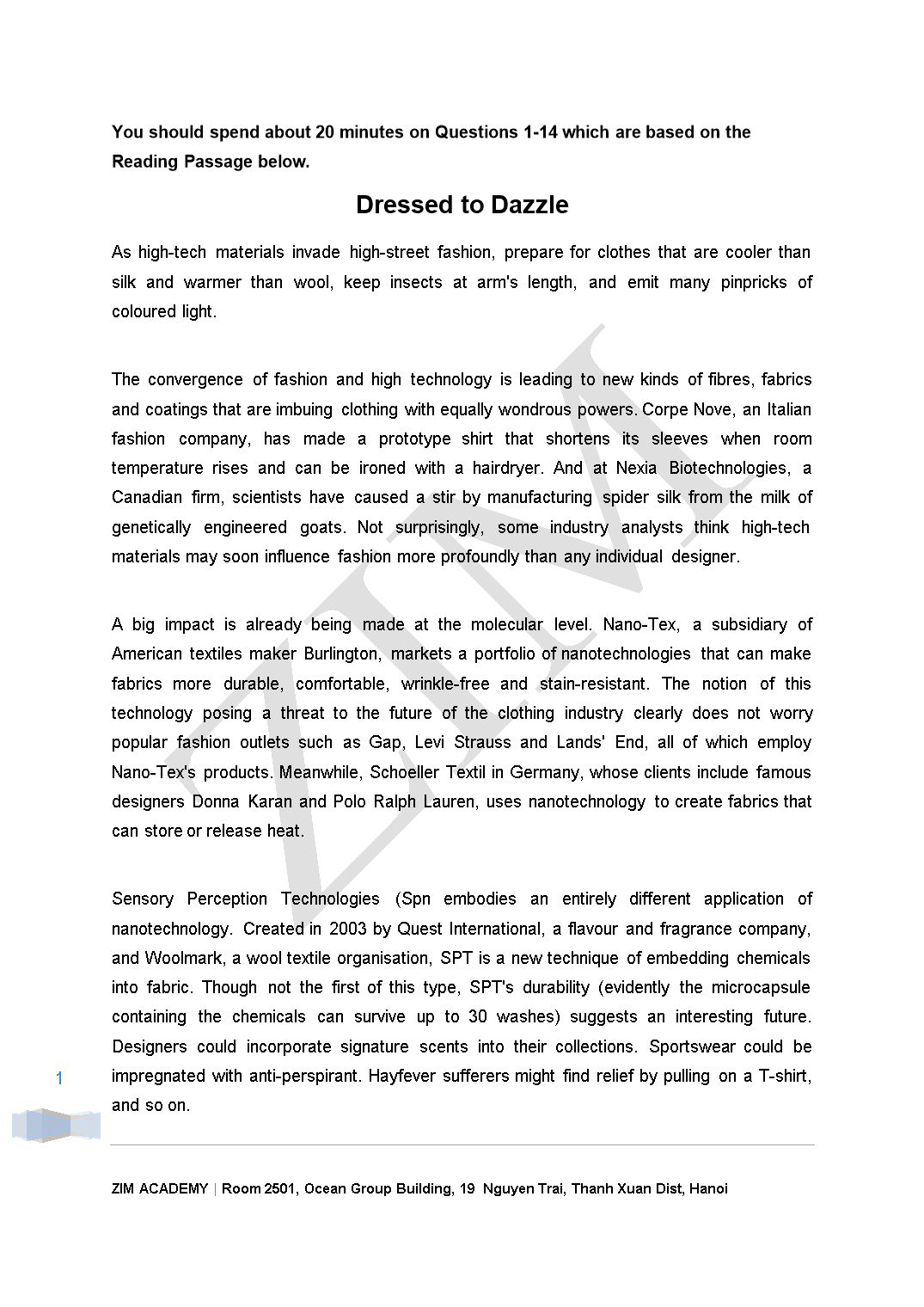
Trang 1
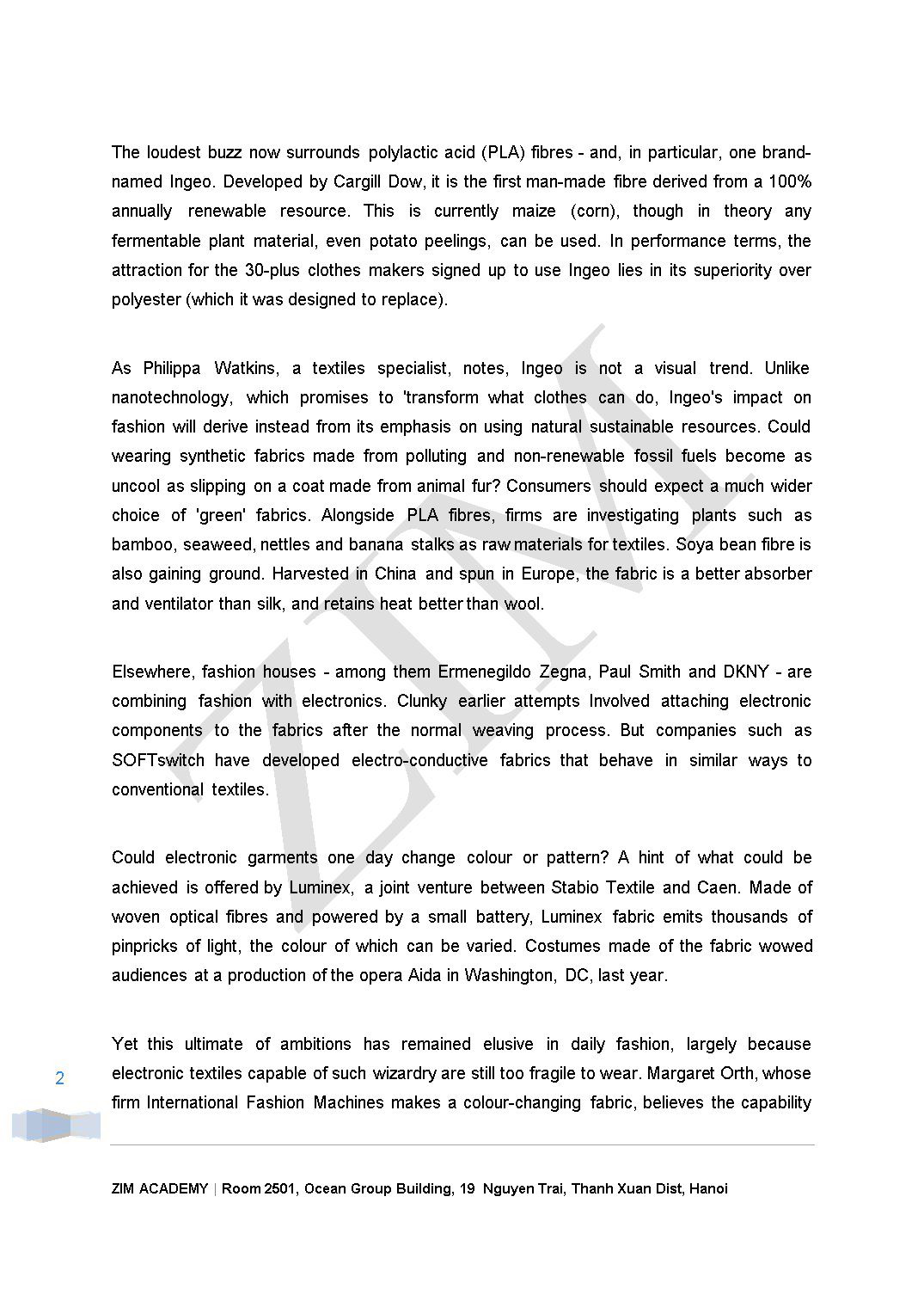
Trang 2
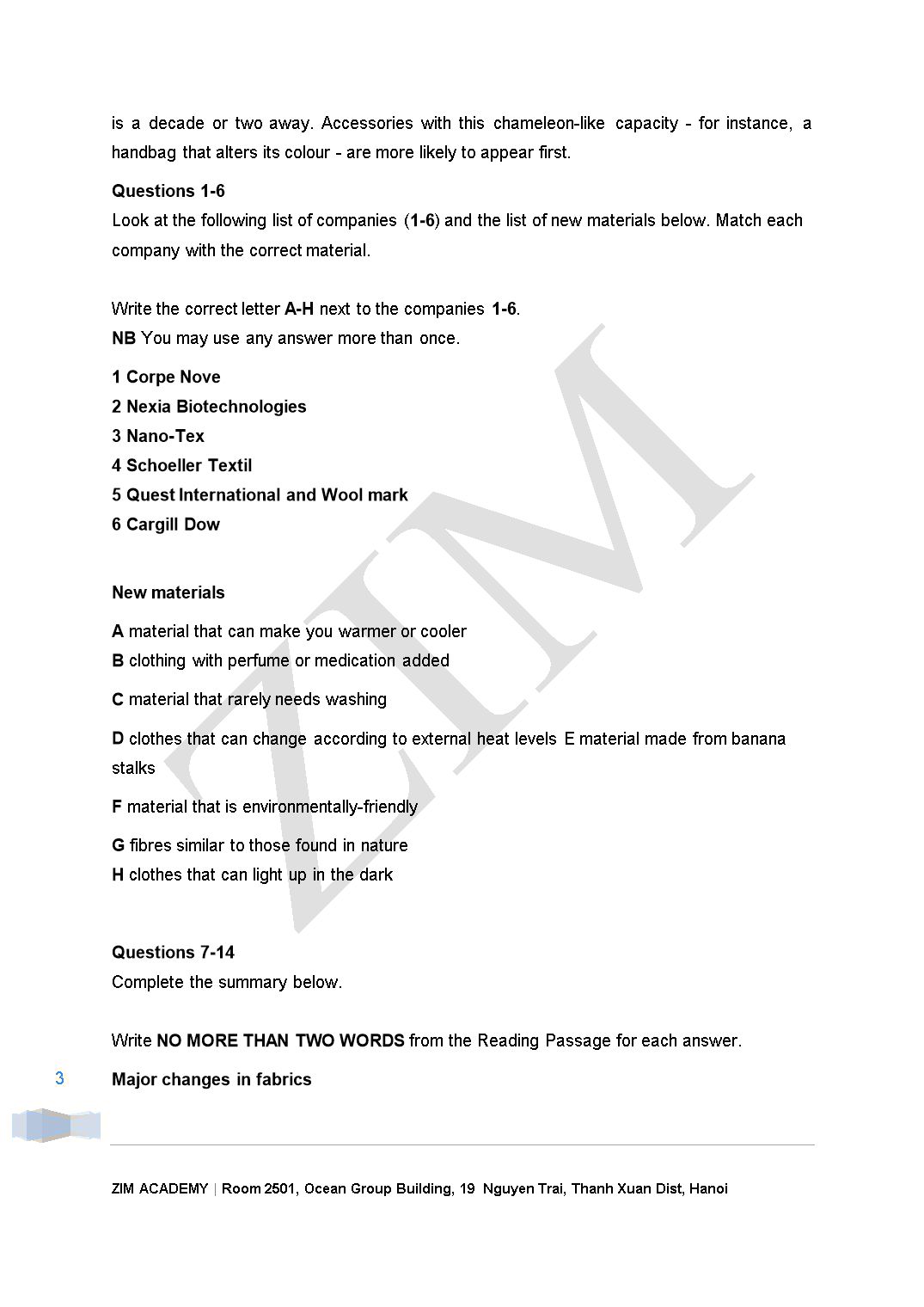
Trang 3
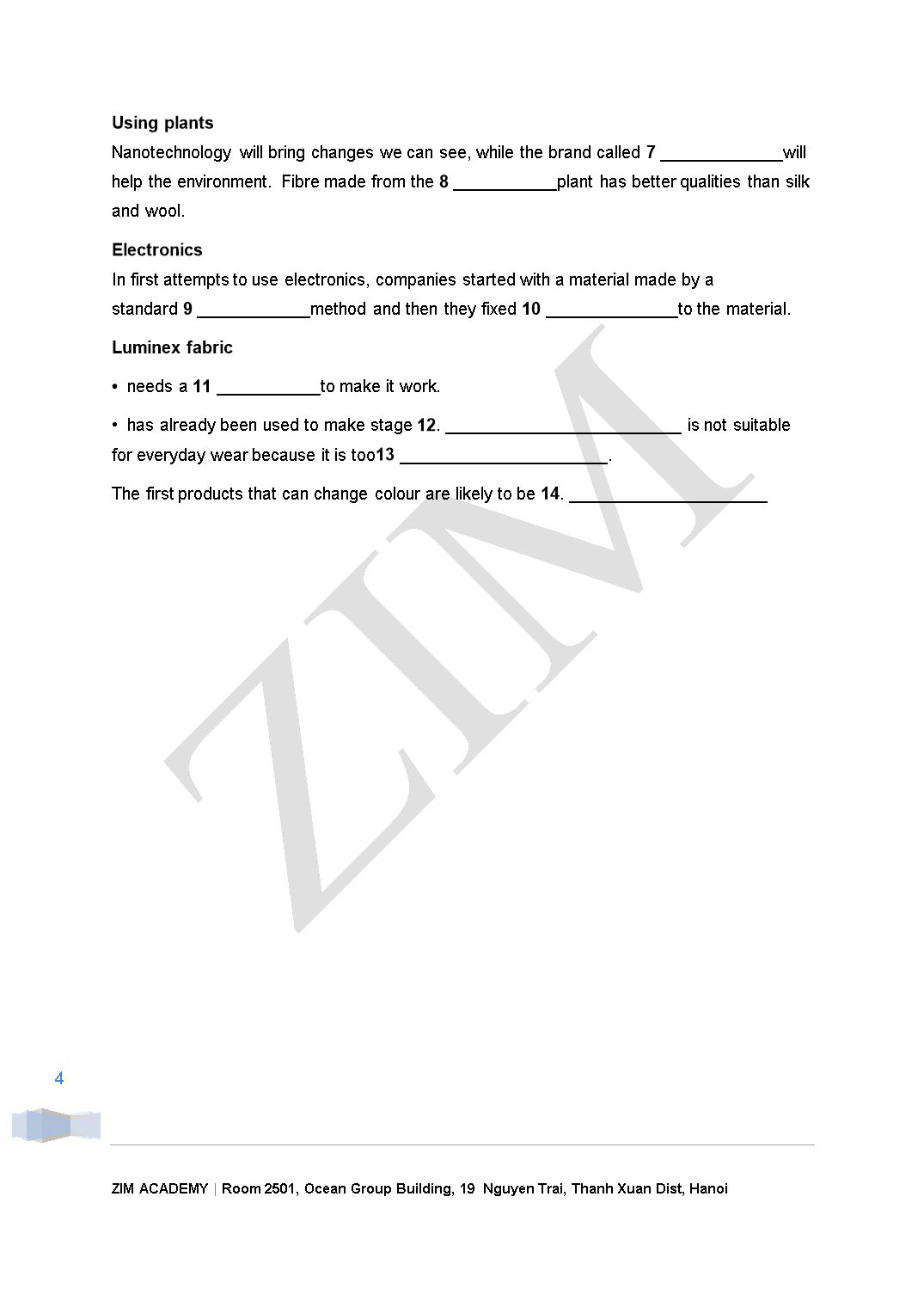
Trang 4

Trang 5
Tóm tắt nội dung tài liệu: Ielts Academic Reading Sample 112
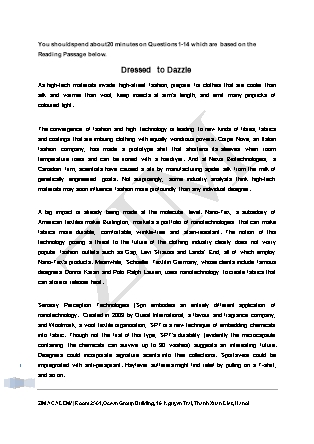
You should spend about 20 minutes on Questions 1-14 which are based on the Reading Passage below. Dressed to Dazzle As high-tech materials invade high-street fashion, prepare for clothes that are cooler than silk and warmer than wool, keep insects at arm's length, and emit many pinpricks of coloured light. The convergence of fashion and high technology is leading to new kinds of fibres, fabrics and coatings that are imbuing clothing with equally wondrous powers. Corpe Nove, an Italian fashion company, has made a prototype shirt that shortens its sleeves when room temperature rises and can be ironed with a hairdryer. And at Nexia Biotechnologies, a Canadian firm, scientists have caused a stir by manufacturing spider silk from the milk of genetically engineered goats. Not surprisingly, some industry analysts think high-tech materials may soon influence fashion more profoundly than any individual designer. A big impact is already being made at the molecular level. Nano-Tex, a subsidiary of American textiles maker Burlington, markets a portfolio of nanotechnologies that can make fabrics more durable, comfortable, wrinkle-free and stain-resistant. The notion of this technology posing a threat to the future of the clothing industry clearly does not worry popular fashion outlets such as Gap, Levi Strauss and Lands' End, all of which employ Nano-Tex's products. Meanwhile, Schoeller Textil in Germany, whose clients include famous designers Donna Karan and Polo Ralph Lauren, uses nanotechnology to create fabrics that can store or release heat. Sensory Perception Technologies (Spn embodies an entirely different application of nanotechnology. Created in 2003 by Quest International, a flavour and fragrance company, and Woolmark, a wool textile organisation, SPT is a new technique of embedding chemicals into fabric. Though not the first of this type, SPT's durability (evidently the microcapsule containing the chemicals can survive up to 30 washes) suggests an interesting future. Designers could incorporate signature scents into their collections. Sportswear could be impregnated with anti-perspirant. Hayfever sufferers might find relief by pulling on a T-shirt, and so on. The loudest buzz now surrounds polylactic acid (PLA) fibres - and, in particular, one brand-named Ingeo. Developed by Cargill Dow, it is the first man-made fibre derived from a 100% annually renewable resource. This is currently maize (corn), though in theory any fermentable plant material, even potato peelings, can be used. In performance terms, the attraction for the 30-plus clothes makers signed up to use Ingeo lies in its superiority over polyester (which it was designed to replace). As Philippa Watkins, a textiles specialist, notes, Ingeo is not a visual trend. Unlike nanotechnology, which promises to 'transform what clothes can do, Ingeo's impact on fashion will derive instead from its emphasis on using natural sustainable resources. Could wearing synthetic fabrics made from polluting and non-renewable fossil fuels become as uncool as slipping on a coat made from animal fur? Consumers should expect a much wider choice of 'green' fabrics. Alongside PLA fibres, firms are investigating plants such as bamboo, seaweed, nettles and banana stalks as raw materials for textiles. Soya bean fibre is also gaining ground. Harvested in China and spun in Europe, the fabric is a better absorber and ventilator than silk, and retains heat better than wool. Elsewhere, fashion houses - among them Ermenegildo Zegna, Paul Smith and DKNY - are combining fashion with electronics. Clunky earlier attempts Involved attaching electronic components to the fabrics after the normal weaving process. But companies such as SOFTswitch have developed electro-conductive fabrics that behave in similar ways to conventional textiles. Could electronic garments one day change colour or pattern? A hint of what could be achieved is offered by Luminex, a joint venture between Stabio Textile and Caen. Made of woven optical fibres and powered by a small battery, Luminex fabric emits thousands of pinpricks of light, the colour of which can be varied. Costumes made of the fabric wowed audiences at a production of the opera Aida in Washington, DC, last year. Yet this ultimate of ambitions has remained elusive in daily fashion, largely because electronic textiles capable of such wizardry are still too fragile to wear. Margaret Orth, whose firm International Fashion Machines makes a colour-changing fabric, believes the capability is a decade or two away. Accessories with this chameleon-like capacity - for instance, a handbag that alters its colour - are more likely to appear first. Questions 1-6 Look at the following list of companies (1-6) and the list of new materials below. Match each company with the correct material. Write the correct letter A-H next to the companies 1-6. NB You may use any answer more than once. 1 Corpe Nove 2 Nexia Biotechnologies 3 Nano-Tex 4 Schoeller Textil 5 Quest International and Wool mark 6 Cargill Dow New materials A material that can make you warmer or cooler B clothing with perfume or medication added C material that rarely needs washing D clothes that can change according to external heat levels E material made from banana stalks F material that is environmentally-friendly G fibres similar to those found in nature H clothes that can light up in the dark Questions 7-14 Complete the summary below. Write NO MORE THAN TWO WORDS from the Reading Passage for each answer. Major changes in fabrics Using plants Nanotechnology will bring changes we can see, while the brand called 7 _____________will help the environment. Fibre made from the 8 ___________plant has better qualities than silk and wool. Electronics In first attempts to use electronics, companies started with a material made by a standard 9 ____________method and then they fixed 10 ______________to the material. Luminex fabric • needs a 11 ___________to make it work. • has already been used to make stage 12. _________________________ is not suitable for everyday wear because it is too13 ______________________. The first products that can change colour are likely to be 14. _____________________ Answer: 1 D 2G 3 C 4A 5 B 6F 7 Ingeo 8 soya bean 9 weaving 10 electronic components 11 battery 12 costumes 13 fragile 14 accessories/ handbags
File đính kèm:
 ielts_academic_reading_sample_112.doc
ielts_academic_reading_sample_112.doc

